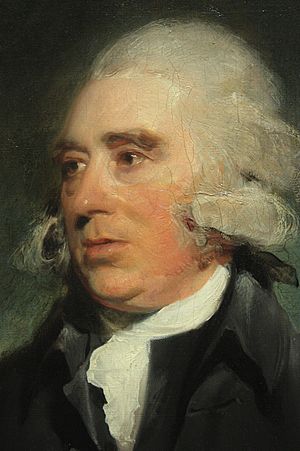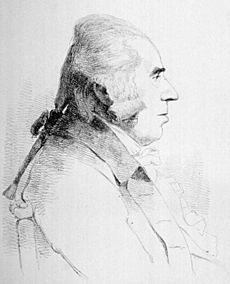John Moore (Scottish physician) facts for kids
Quick facts for kids
John Moore
|
|
|---|---|

A painting of the Duke of Hamilton on his Grand Tour with Dr. John Moore and his son, John. They stayed in Geneva for two years. Painted by Jean Preudhomme in 1774.
|
|
| Born | 1729 Stirling, Scotland
|
| Died | 21 January 1802 (aged 72–73) London, England
|
| Nationality | Scottish |
| Occupation | Physician, author |
| Children | General Sir John Moore Admiral Sir Graham Moore Dr. James Moore James Carrick Moore |

John Moore (born 1729, died 1802) was a Scottish doctor and a writer. He wrote about his travels and also helped edit books by another writer named Tobias Smollett.
Contents
John Moore's Early Life and Education
John Moore was born in Stirling, Scotland, on October 10, 1729. When he was young, his family moved to Glasgow. He went to Glasgow Grammar School. After school, he trained to be a doctor with Dr. John Gordon from 1745 to 1747.
Becoming a Doctor and Traveling
After getting his medical degree from the University of Glasgow, John Moore worked as a surgeon's assistant. He served with the army in Flanders during the Seven Years' War. Later, he went to London to continue his studies. He then traveled to Paris, where he became the surgeon for the British ambassador's family.
In 1751, he returned to Glasgow and worked again with Dr. John Gordon. From 1769 to 1778, he went on a long trip around Europe called a "Grand Tour." He traveled with the Duke of Hamilton. When he came back, he settled in London.
Witnessing the French Revolution
In 1792, John Moore went to Paris with Lord Lauderdale. He saw many important events of the French Revolution. His book, Journal during a Residence in France (published in 1793), is a detailed record of what he saw. This book is often mentioned by the famous writer Thomas Carlyle.
Later Life and Recognition
In 1784, John Moore was chosen to be a member of the Royal Society of Edinburgh. This is a group of important thinkers and scientists. He died in Richmond, which is now part of London, on February 21, 1802. He was buried in Paradise cemetery.
John Moore's Books and Writings
John Moore wrote several popular books. His novel Zeluco (1789) was about a selfish person. It made a big impression at the time. The famous poet Lord Byron even said his character Childe Harold was inspired by Zeluco.
Moore's other popular books described society and manners in different countries. These included A View of Society and Manners in France, Switzerland and Germany (1779) and A View of Society and Manners in Italy (1781).
Mordaunt and Travel Observations
His novel Mordaunt was published in three parts. It was written after the French Revolution. This book included 34 character sketches of important people like politicians and royalty. It also shared Moore's observations from his travels across Europe in the late 1700s. The book even mentioned the brave actions of a British officer, who was Moore's own son, General Moore.
John Moore's Family
John Moore had eight sons and three daughters with his wife, Jean Simson. His eldest surviving son was General Sir John Moore, a very famous soldier. John Moore's wife died in 1820.
His other sons included Dr. James Carrick Moore (1762–1860), who wrote a book about his brother, General Sir John Moore. Another son was Sir Graham Moore (1764–1843), who became an admiral in the navy.


